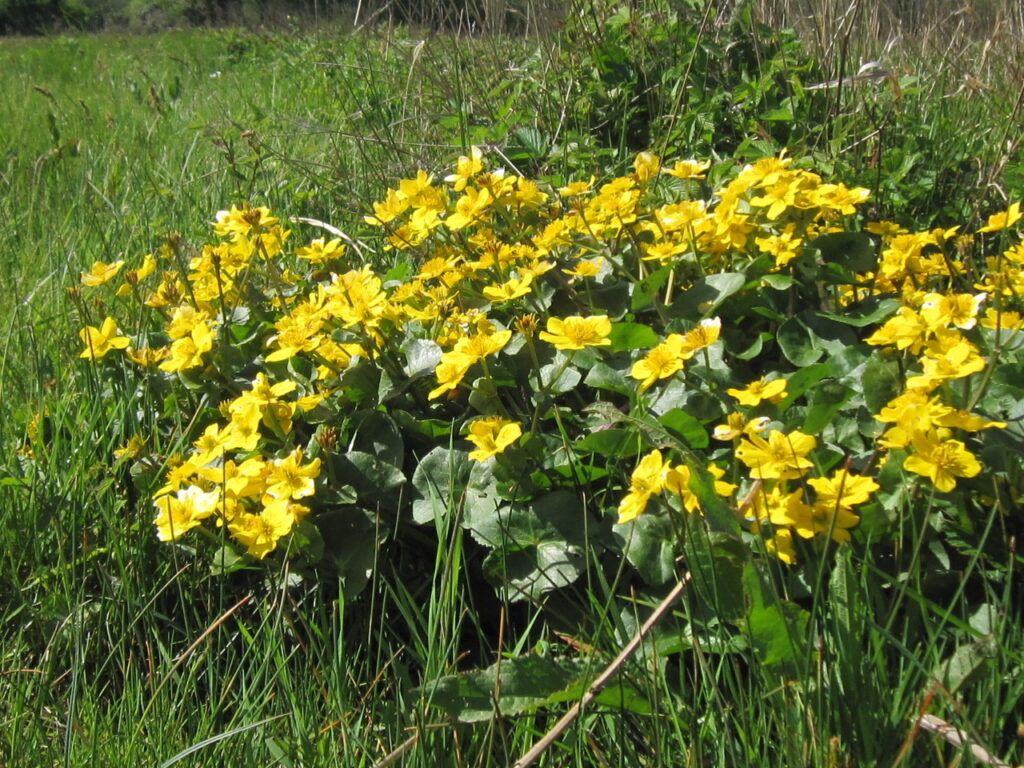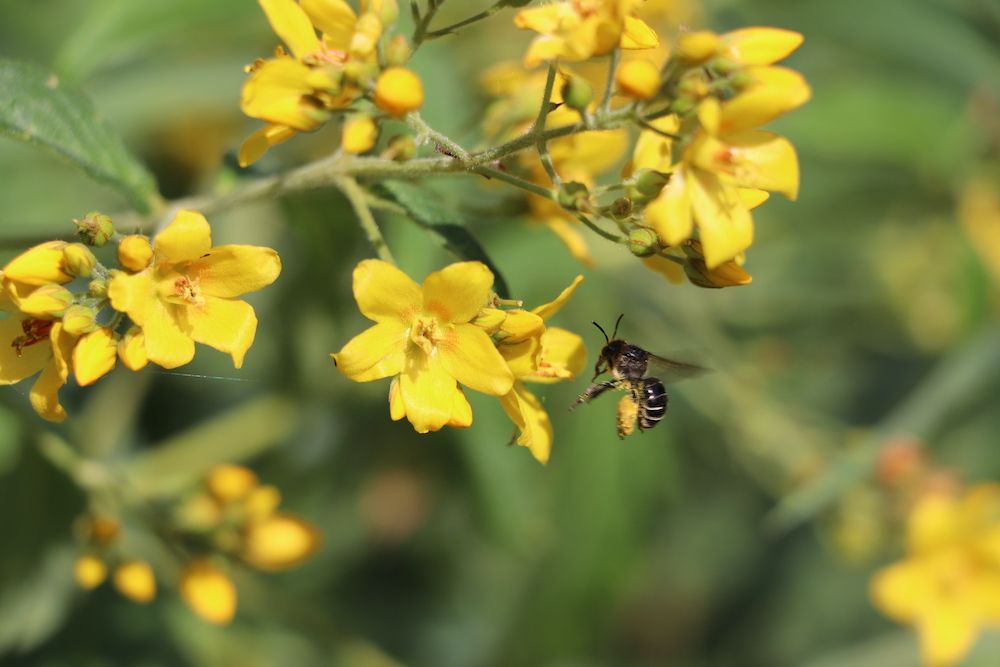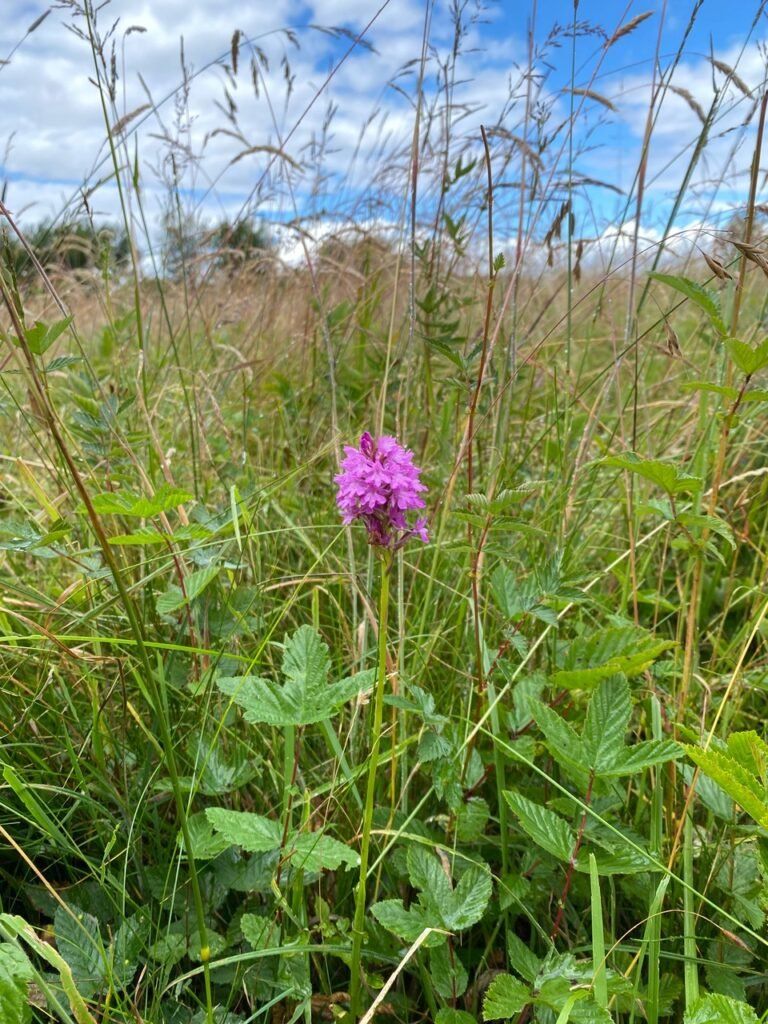Tell it to the Bees
- 23 March 2023
-
 Faith Moulin
Faith Moulin
- Bees, Flowers & Plants, Stowey
The fourth in a series of blogs about YACWAG’s fields and their secrets.
You can view the previous entries here.
Part 1: Fields Hold Secrets
Part 2: A Small Field with a Big Secret
Part 3: From Nags to Niches – Having a Field Day
Sue Clifford of Common Ground, the conservation charity, wrote “Every place is its own living museum”. This applies to every field, every scrap of green land we overlook every day. Fields aren’t just nowhere and nothingness. The fields that surround us are holding their secrets, just waiting for us to discover them. Tony and I had the fun and pleasure during one of the lockdowns of teasing out a secret from one of YACWAG’s fields called Middlemead (adjacent to the watercourse called Middle Rhyne) and that is the story I am going to tell you in this blog.

Wetland Plants Welcome Here
We knew when we purchased Stowey Reserve (two fields off Stowey Road called Middlemead and Westmead), that they contained some interesting wild flowers. A hundred year old eye-witness account talked of grips (field drains which give local fields their characteristic ridged appearance) full of Marsh Marigolds in the spring in all the marshy fields to the north of the High Street. In Middlemead, the most southerly field, you can actually see them just like that, growing in the grips in the open field. There were 13 plants when we bought the field, now there are over 100. Ragged Robin also thrived in the damp grassland at that time but the field has been drying out since and the dry springs have made it difficult for wetland species that don’t have long roots. Ragged Robin is just hanging on, mainly in the grips. Another rarity was Yellow Loosestrife. This plant was known from around Yatton in 1912 (ref: White’s Flora of Bristol) but by 2005 it had disappeared from all the places we had seen it in Yatton since we moved here in 1975. At Stowey Reserve, particularly in Westmead, it grew on some of the ditch edges, late summer flowering and the colour of butter. It evidently liked our relaxed style of management because in 2017 it popped up in one of the grips in Middlemead, perhaps spread on the tractor tyres during hay-making, and set off to form a big patch in the open field by means of its rhizomatous roots. That behaviour isn’t in the books. Our contractor patiently humoured us and cut round the patch.
Bees Please
During the first lockdown of 2020 our normal life was on hold and we seemed to have a lot of time. We had been reading about bees, and learned that there was such a thing as a Yellow Loosestrife Bee (Macropis europaea). Tony and I decided one afternoon at the time that species was active to go and check out our patch of Yellow Loosestrife in Stowey Reserve to see if we could find it. What happened next astonished me. I left Tony poised on the edge of the Yellow Loosestrife patch and wandered off over the other side of the field. I pottered about looking at plants and eventually walked back to see how he was getting on. To my amazement he said, ‘I think I’ve seen it,’ and described a medium-sized bee whose hind legs were coated in yellow dust, literally bathed in pollen. I had not expected him to see one, and my lack of faith was punished by not seeing one on that occasion because it was too far for him to shout across the field to share the experience with me. We went home and examined the photos he had taken. There wasn’t much doubt about the identification but we found we were 50 miles from the next nearest known colony on the Somerset Levels where the plant grows more abundantly.

The Yellow Loosestrife Bee is a medium-sized dark bee which collects pollen from the Yellow Loosestrife flowers. Its USP is that the oils from both the flower and the pollen enable the bee to manufacture a waterproof wax from it to line its nest chambers. It nests underground, in wet peaty soil, often near ditch edges, close to the important Yellow Loosestrife, so it needs that waterproofing to safeguard the eggs and young grubs in their nest chambers. It is one of a few ground-nesting bees able to cope with damp soils. They nest singly or in small groups, always in association with Yellow Loosestrife.
BBC Radio Bristol covered the discovery and put an article on their website, giving the bees their 15 minutes of fame. At the same time we also photographed a rare sawfly – but sawflies aren’t ‘sexy’ like bees so that had no media interest.
Lucky for Bees, Lucky for YACWAG
All I could think about that evening was the ‘luck’ of the bees that YACWAG had bought the field where Yellow Loosestrife grows. What if a farmer had bought it, or a horse-owner? The plant would have been lost and the bees with it. No-one would even have known it was there. It was living in secret on the edge of our field, unexpected, unlooked for, next stop Extinction. Nature is really fragile. It is very easy to see how ignorance goes hand in hand with the loss of biodiversity. So YACWAG is now on a mission to know what is on its land so that we can secure its future.
We have to change the way we do things, we have to be willing to learn and to adapt our behaviour to what we have learnt firsthand. We had been enthusiastically providing Warre hives for honey bees on our land until we looked into what is happening to wild bees. There are over 250 species of bee in the UK and many of them are threatened. Honey bees compete with them for food, often on sites that are only marginal. There just aren’t enough flowers to go round! We want to encourage more flowers for bees at Stowey Reserve so the rare bees don’t lose out. When the hive bees we have introduced die out, we will remove the hive and put our efforts into our wild bees.

Westmead in our Stowey Reserve yielded one of its secrets which it might well have been guarding for centuries. We might never have known if Covid-19 hadn’t come along. However, more surprises were to come. In 2022 a bright pink flower was spotted in the long grass in Middlemead. It was the first known orchid on YACWAG land! Somehow a Pyramidal Orchid had struggled up through the vegetation. Another wonderful secret coaxed forth by gentle management. What will we discover this year?
Faith Moulin
© Copyright YACWAG, or original authors. All rights reserved. | Registered charity 1076362 | Privacy policy | Cookie policy | Terms & Conditions |Web design: StanfordGraphics


